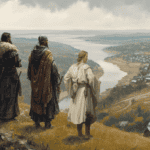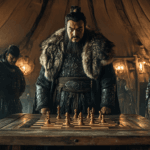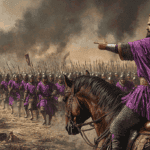
The Battle of Kalka River, fought on May 31, 1223, marked the first significant Mongol incursion into Europe and demonstrated the devastating effectiveness of their military tactics. This clash between the Mongol Empire, led by generals Jebe and Subutai, and a coalition of Kievan Rus’ princes and their Cuman allies foreshadowed the future Mongol domination of Eastern Europe.
Background: The Rise of the Mongols
By the early 13th century, the Mongol Empire under Genghis Khan had rapidly expanded across Asia, defeating powerful kingdoms such as the Khwarezmian Empire. Genghis Khan’s generals, Jebe and Subutai, were tasked with reconnaissance missions that doubled as campaigns of conquest. After subjugating regions in Central Asia and the Caucasus, they turned their attention westward toward the steppes of Eastern Europe.
The Cumans, a nomadic Turkic people inhabiting these steppes, were among the first to encounter the Mongols. After suffering defeats at their hands, the Cuman Khan sought refuge with his son-in-law, Mstislav Mstislavich of Galicia (known as Mstislav the Bold). The Cumans convinced him to rally other Rus’ princes to form an alliance against this new threat. This coalition included Mstislav III of Kiev and other regional leaders who agreed to confront the Mongols together.

The Prelude to Battle
The Mongols employed their signature tactic—a feigned retreat—to lure their enemies into a vulnerable position. For nine days, Jebe and Subutai’s forces appeared to flee before the advancing Rus’-Cuman coalition. This tactic played on the overconfidence of their opponents, who believed they were pursuing a retreating enemy.
On May 30, 1223, after days of pursuit, the coalition reached the Kalka River (likely near modern-day Mariupol in Ukraine). The allied forces crossed the river and set up camps on both sides. Mstislav III of Kiev positioned his contingent on a steep hill for defensive purposes, while other forces camped closer to the riverbanks.
The Course of Battle
The battle began with a sudden Mongol counterattack. Using their highly mobile cavalry and expert horse archers, the Mongols unleashed volleys of arrows on the coalition forces. The Cumans were among the first to break ranks and flee, creating chaos within the Rus’ lines. This disarray allowed the Mongols to exploit gaps in their enemy’s formation.

The coalition forces were divided into smaller groups as they tried to reorganize. The Mongols encircled these fragmented units with precision. Smoke bombs further disrupted communication among the Rus’ troops. One by one, each segment of the coalition army was overwhelmed by relentless attacks from all sides.
Mstislav III of Kiev remained on his fortified hill but was eventually surrounded by Mongol forces. After a brief siege, he surrendered under promises of safe passage for himself and his men. However, this promise was treacherously broken; Mstislav and his nobles were executed by being crushed beneath wooden planks while Mongol soldiers feasted atop them—a grim demonstration of Mongol ruthlessness.
Aftermath: Consequences for Eastern Europe
The defeat at Kalka River was catastrophic for the Rus’ principalities and their Cuman allies: the coalition suffered massive losses—approximately 20,000 out of 30,000 soldiers were killed—while Mongol casualties were minimal. The deaths of numerous Rus’ princes destabilized Kievan Rus’, weakening its ability to resist future invasions. The Cumans fled westward after their defeat, some seeking refuge in Hungary.
Despite their overwhelming victory, Jebe and Subutai did not immediately press further into Europe. Instead, they returned eastward to report back to Genghis Khan. Their reconnaissance mission had successfully mapped out potential targets for future campaigns while demonstrating Mongol dominance over European forces.

Military Significance
The Battle of Kalka River highlighted several key aspects of Mongol warfare:
- The ability to lure enemies into traps through false retreats was a hallmark of Mongol strategy.
- The highly disciplined cavalry allowed for rapid maneuvers that outpaced less organized armies.
- The execution of captured leaders sent a clear message to future adversaries about the consequences of resistance.
These tactics would later be employed during subsequent invasions of Eastern Europe in 1237–1240 when Batu Khan led a full-scale campaign that culminated in the fall of Kiev.




